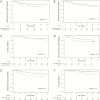Aspirin and COX-2 inhibitor use in patients with stage III colon cancer
- PMID: 25432409
- PMCID: PMC4271076
- DOI: 10.1093/jnci/dju345
Aspirin and COX-2 inhibitor use in patients with stage III colon cancer
Abstract
We conducted a prospective, observational study of aspirin and COX-2 inhibitor use and survival in stage III colon cancer patients enrolled in an adjuvant chemotherapy trial. Among 799 eligible patients, aspirin use was associated with improved recurrence-free survival (RFS) (multivariable hazard ratio [HR] = 0.51, 95% confidence interval [CI] = 0.28 to 0.95), disease-free survival (DFS) (HR = 0.68, 95% CI = 0.42 to 1.11), and overall survival (OS) (HR = 0.63, 95% CI = 0.35 to 1.12). Adjusted HRs for DFS and OS censored at five years (in an attempt to minimize misclassification from noncancer death) were 0.61 (95% CI = 0.36 to 1.04) and 0.48 (95% CI = 0.23 to 0.99). Among 843 eligible patients, those who used COX-2 inhibitors had multivariable HRs for RFS, DFS, and OS of 0.53 (95% CI = 0.27 to 1.04), 0.60 (95% CI = 0.33 to 1.08), and 0.50 (95% CI = 0.23 to 1.07), and HRs of 0.47 (95% CI = 0.24 to 0.91) and 0.26 (95% CI = 0.08 to 0.81) for DFS and OS censored at five years. Aspirin and COX-2 inhibitor use may be associated with improved outcomes in stage III colon cancer patients.
© The Author 2014. Published by Oxford University Press. All rights reserved. For Permissions, please e-mail: journals.permissions@oup.com.
Figures

Comment in
-
RE: Aspirin and COX-2 Inhibitor Use in Patients With Stage III Colon Cancer.J Natl Cancer Inst. 2015 Jun 4;107(8):djv149. doi: 10.1093/jnci/djv149. Print 2015 Aug. J Natl Cancer Inst. 2015. PMID: 26048994 Free PMC article. No abstract available.
-
Response.J Natl Cancer Inst. 2015 Jun 4;107(8):djv150. doi: 10.1093/jnci/djv150. Print 2015 Aug. J Natl Cancer Inst. 2015. PMID: 26048995 Free PMC article. No abstract available.
References
-
- Steinbach G, Lynch PM, Phillips RK, et al. The effect of celecoxib, a cyclooxygenase-2 inhibitor, in familial adenomatous polyposis. N Engl J Med. 2000;342(26):1946–1952. - PubMed
-
- Sandler RS, Halabi S, Baron JA, et al. A randomized trial of aspirin to prevent colorectal adenomas in patients with previous colorectal cancer. N Engl J Med. 2003;348(10):883–890. - PubMed
-
- Baron JA, Cole BF, Sandler RS, et al. A randomized trial of aspirin to prevent colorectal adenomas. N Engl J Med. 2003;348(10):891–899. - PubMed
-
- Benamouzig R, Deyra J, Martin A, et al. Daily soluble aspirin and prevention of colorectal adenoma recurrence: one-year results of the APACC trial. Gastroenterology. 2003;125(2):328–336. - PubMed
-
- Bertagnolli MM, Eagle CJ, Zauber AG, et al. Celecoxib for the prevention of sporadic colorectal adenomas. N Engl J Med. 2006;355(9):873–884. - PubMed
Publication types
MeSH terms
Substances
Grants and funding
LinkOut - more resources
Full Text Sources
Other Literature Sources
Research Materials

